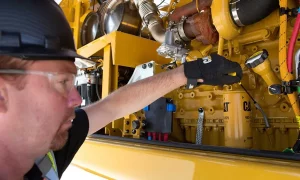In the realm of steel fabrication, machinery downtime can silently impact profits and hinder production goals. Often overlooked, regular maintenance is crucial to prevent unplanned repairs and extended downtime. Prioritizing effective machinery upkeep can lead to reduced expenses, enhanced productivity, and prolonged equipment lifespan. What strategies can mitigate machinery failures and optimize resource allocation for steel fabrication businesses?
Key Takeaways
- Implementing a scheduled maintenance program helps minimize unplanned stops in production and reduces significant losses.
- Regular inspections and timely part replacement decrease the likelihood of repair, reducing production disruptions and costs.
- Effective maintenance practices, such as tracking equipment history and training personnel, are essential for maximizing profitability in steel fabrication businesses.
• Conducting regular checks helps identify potential issues, reducing waste and optimizing resource allocation, leading to increased productivity and profitability. - Proper machinery maintenance is crucial for extending equipment lifespan, maximizing machinery investment, and ensuring equipment reliability and performance.
Machinery Downtime: A Hidden Cost
Equipment downtime is a silent assassin of steel fabrication businesses, quietly eroding profit margins and jeopardizing timely project completion. Unplanned stops in production lead to significant losses, affecting not merely revenue but customer satisfaction as well. By implementing effective Machinery Maintenance Tips, businesses can minimize equipment downtime, ensuring continuous production and maximizing profitability.
Tips for Effective Machinery Maintenance
To guarantee peak equipment performance and minimize unplanned stops, five key maintenance practices should be integrated into a steel fabrication business’s daily operations. Implementing a scheduled maintenance program, tracking equipment history, and training personnel on Machinery Maintenance Tips are crucial. Furthermore, conducting regular inspections and addressing minor issues promptly can significantly reduce downtime and increase overall efficiency.
Boosting Productivity With Regular Checks
Regular equipment inspections can help identify potential issues before they escalate into major problems, allowing steel fabrication businesses to maintain a smooth and efficient production workflow. By incorporating Machinery Maintenance Tips into their routine, businesses can minimize downtime, reduce waste, and optimize resource allocation, ultimately leading to increased productivity and profitability.
Reducing Unplanned Machinery Repairs
Implementing a preventative maintenance schedule can significantly decrease the likelihood of unforeseen machinery repairs, thereby minimizing production disruptions and associated costs. By incorporating Machinery Maintenance Tips, such as regular inspections and timely replacement of worn parts, steel fabrication businesses can guarantee seamless operations and avoid costly downtime. This proactive approach optimizes resources, improves efficiency, and boosts overall productivity.

Frequently Asked Questions
How Often Should Machinery Maintenance Records Be Updated?
Regularly updating machinery maintenance records is vital; aim to update records daily or weekly, ensuring precision and facilitating efficient tracking of maintenance schedules, repairs, and parts replacement to guarantee peak machinery performance.
What Are the Consequences of Ignoring Machinery Maintenance Schedules?
Neglecting machinery maintenance schedules can lead to severe consequences, including equipment failure, production downtime, and compromised product quality, ultimately resulting in financial losses, reputational damage, and potential safety hazards.
Can Machinery Maintenance Be Outsourced to Third-Party Providers?
Yes, equipment maintenance can be outsourced to third-party providers, allowing steel fabrication businesses to tap into specialized expertise, reduce costs, and improve overall equipment reliability and uptime.
Are There Any Industry-Specific Machinery Maintenance Regulations?
In the steel fabrication industry, regulatory bodies like OSHA and EPA enforce machinery maintenance standards, while industry associations like ASME and AWS provide guidelines, ensuring compliance with safety and quality standards.
What Is the Ideal Machinery Maintenance Frequency for High-Use Equipment?
For high-utilization equipment, the ideal machinery maintenance frequency involves a combination of routine checks, condition-based monitoring, and predictive maintenance, with a minimum of weekly inspections and monthly in-depth maintenance sessions.
Conclusion
In summary, implementing effective machinery maintenance strategies is vital for steel fabrication businesses to minimize downtime, reduce production disruptions, and improve overall productivity. By establishing a scheduled maintenance program, tracking equipment history, and conducting regular inspections, businesses can guarantee smooth operations, prolonged machinery lifespan, and optimized resource allocation. This proactive approach not only prevents unplanned repairs but also contributes to boosting profitability through increased efficiency and reduced downtime expenses.
You May Also Like:






